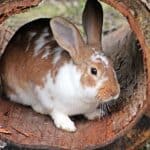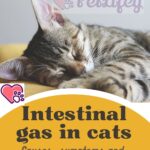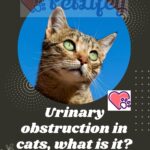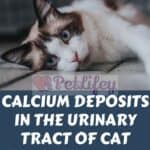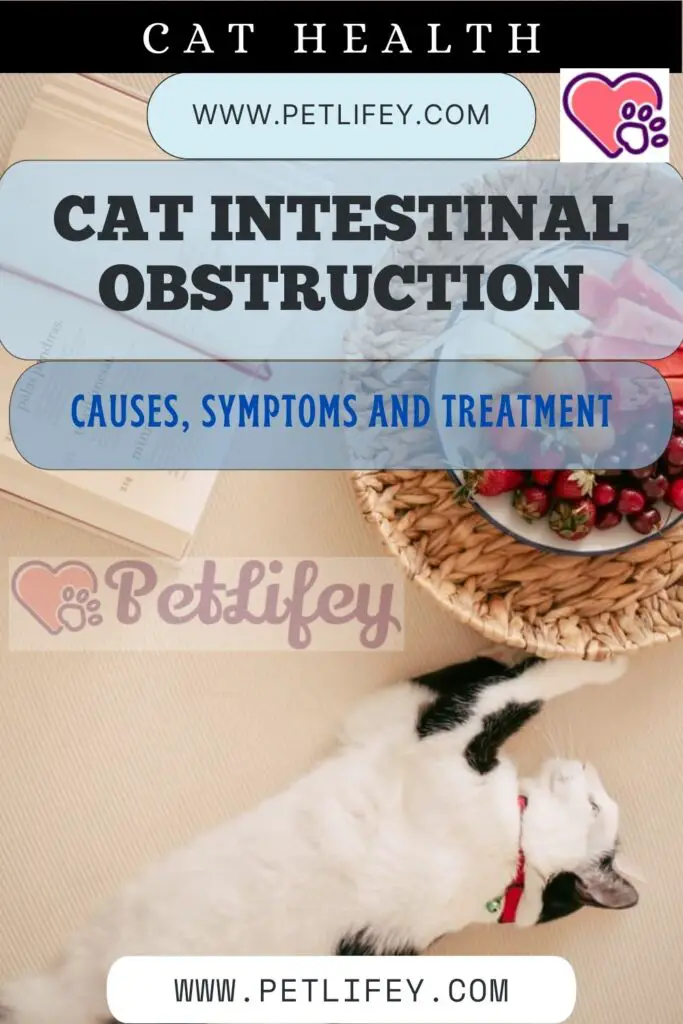
My cat has swallowed an object, does it risk intestinal obstruction? What are the symptoms and how to treat them? Do we have to intervene surgically? We recognize the symptoms, causes and treatment of intestinal obstruction in cats.
Intestinal obstruction is an almost mechanical disorder that consists in the total or partial closure of the passage of food in the intestine of the cat.
The occlusion can be:
- Total intestinal obstruction
- Partial bowel obstruction
Total intestinal obstruction
Total intestinal obstruction is often caused by cat hairballs forming in the cat’s stomach and getting stuck in the small intestine when their size gets too large. It can also be caused by ingesting a foreign body (a bone, rag, sponge, piece of plastic, string, or ball) that cannot pass through the intestine.
Other causes are also may be generating occlusion are:
- A tumor in the cat that develops in the intestine
- An umbilical hernia containing a portion of the intestine
- Contamination of the intestine with worms such as roundworms (frequent parasites in cats)
- Constipation which can lead to coprostasis (slow fecal traffic): accumulation of bulky stools in the intestine
Partial intestinal obstruction
In the case of partial intestinal obstruction, there is an incomplete obstruction of the digestive tract, i.e., intestinal transit is significantly slowed down but is still achieved. This is referred to as intestinal sub-occlusion.
Symptoms of total intestinal obstruction in cats
The symptoms observed are:
- Vomiting of the cat
- The cat is weak and dehydrated
- Any small amounts of soft, liquid and bloody stools, if any. But most of the time there is no stool
- Abdominal pain (localized distention of the belly may be observed in some cases). This pain is aggravated if we manage to visit the cat, carrying out a palpation of the abdominal area. The cat often adopts a “prayer” position to relieve the pain in itself.
- possibly cat fever (a cat’s normal temperature is between 38 ° C and 39 ° C).
- Be careful, the cat can produce a peculiar cough if it tries to regurgitate the hair without succeeding.
Attention! Intestinal obstruction can cause lesions in the small intestine of the cat: necrosis, perforation of the intestine. In case of symptoms, it is therefore advisable to consult a veterinarian quickly to avoid complications.
Symptoms of partial bowel obstruction
Symptoms are almost the same as for total intestinal obstruction:
- Decreased form, appetite and possible vomiting.
- Almost complete cessation of stool and / or constipation.
- bloating and cat discomfort on abdominal palpation.
- A posture that reduces pain: the cat changes its position (in “prayer”) to try to reduce the pain felt.
The greater the intestinal obstruction (at the beginning of the digestive tract) of the cat, the more intense the symptoms and the rapid evolution. When the intestinal obstruction is very low (towards the end of the digestive tract), the cat slowly gets worse.
Attention! The digestive tract begins in the mouth! Any excessive salivation from your cat can be indicative of a foreign body stuck behind the soft palate or stuck in the mouth.
Diagnosis of intestinal obstruction in cats
After a complete clinical examination of the cat, including palpation of the abdomen, the diagnosis of partial intestinal obstruction, such as that of total intestinal obstruction, usually uses ultrasound to evaluate the appropriate treatment:
- A simple x- ray of the cat’s digestive system.
X-ray examination of the cat’s digestive system can reveal the visible presence of the foreign body if it is radioactive (for example the needle seam but if it is a lock of hair, it will not be visible on a simple X-ray) or a strong constipation in the cat or the presence of important gas.
- X -ray with contrast material (or barium transit) of the cat’s digestive tract.
Several x-rays are taken before and after the cat ingested a radiopaque contrast agent (barite). This helps locate the sub-occlusion and assess its intensity. Anesthesia may be needed to perform this test.
- An abdominal ultrasound of the cat.
An ultrasound of the abdomen may also be helpful in diagnosing intestinal obstruction in cats.
Treatment of intestinal obstruction in cats
Surgery is usually done in cases of total intestinal obstruction from gastrostomy: opening of the stomach or enterotomy: opening of the intestine.
The latter is the only way to resolve the condition unless the foreign body is vulnerable (which hurts) and is in the upper part of the digestive tract (stomach, early small intestine) and can be extracted by endoscopy: exploration that uses an endoscope to view the inside of the digestive tract and that requires a general anesthetic.
Drug therapy will be added to the surgery and an infusion to rehydrate the cat. The resumption of feeding of the cat will be gradual but early with a food suitable for the cat (usually pate) prescribed by the veterinarian.
Attention! Linear foreign objects such as strings are particularly dangerous. They can cut the intestine along its length and cause injury in such a way that if treatment is not done in time, an enterectomy (removal of a portion of the intestine) may be required.
Treatment of partial bowel obstruction
When the general condition of the cat is satisfactory (this is for example the case when the symptoms are recent or if the obstruction is weak or when the foreign body is relatively malleable), the veterinarian will begin by prescribing a drug treatment, based on of lubricants and / or various products that facilitate the transit, to try to free the digestive tract.
Attention, contrary to a false belief, edible oils do not lubricate the digestive system, some are recommended for their capacity in essential fatty acids that have an action on the beauty of the hair and the ecosystem of the skin.
Only the paraffin oil is not digested and absorbed by the intestine and can therefore facilitate the transit, it is advisable to administer it to the cat in the form of an appetizing food paste. The liquid form can lead to a false route of the product (risk of associated pneumonia) especially if the cat does not agree!
Typically a specific diet higher in fiber or a special constipation for dietary foods is required for the cat. Ask your vet for advice. When the case calls for it, the vet may need to rehydrate the cat and initiate antibiotic treatment.
Prognosis of intestinal obstruction in cats
The prognosis of intestinal obstruction in cats is largely influenced by the nature of the associated digestive lesions and its digestive localization (as we have said, a high occlusion, i.e. at the beginning of the digestive tract, is more life-threatening. of a low occlusion, i.e. at the end). In case of acute frequent vomiting, consult a veterinarian immediately, as the prognosis is better the sooner the diagnosis is made. Appropriate therapy can be started as soon as possible
Prevention of intestinal obstruction in cats
There are some risk factors that lead to intestinal obstruction in cats such as:
- Lack of maintenance of the cat’s skin and coat, especially if its hair is long
- Likewise, not treating it preventively against parasites can lead to an itch in case of a flea infestation . Itching occurs by scraping but also licking it, it can be led to ingesting the hair in larger quantities.
- The way of life of the cat. A cat that has access to the outdoors will ingest the grass and shed more easily than a cat in the house that does not have a preventative treatment against the accumulation of hair in the digestive tract.
- Furthermore, the poverty in the stimuli of the closed environment (the cat does not go out) can favor the appearance of an anxious state that the cat will try to appease by licking itself (replacement activity).
- Physical inactivity, as opposed to physical activity, slows down digestive transit (and therefore promotes stagnation of hair in the digestive tract) and promotes overweight, another factor that promotes gastrointestinal appearance and constipation.
- The medical history of the cat
- Chronic constipation or excessive sedentary lifestyle related to age (concomitant osteoarthritis, lack of activity) will be predisposing factors to the slowing of digestive transit and therefore to the risk of intestinal obstruction.
- The cat’s diet. Cats are certainly carnivores but the lack of dietary fiber in the diet is an unfavorable factor for good intestinal transit.
- The emotional state of the cat. An anxious or depressive condition of the cat, whatever its origin, can disturb the grooming behavior in the direction of an increase leading to an abnormal accumulation of hair in the digestive tract.
Suggestions
To prevent any risk of intestinal obstruction in cats, it is first of all recommended not to leave small objects lying around and that the cat may accidentally swallow while playing:
- Close the package containing pins, needles, buttons, spools of sewing thread
- Store the various hair bands and scratches in a closed cabinet.
- Don’t leave strings of wire, especially wire (soaked in blood) around the roast beef – quickly unwrap it after cutting the meat.
- Store all balls of yarn of all types.
- Don’t leave garbage bags lying around with links.
- Some small toys can also be ingested like marble or bone
Other basic tips to prevent
To prevent hairballs (also called trichobézoards) from forming in the digestive tract, start by brushing your cat daily and very frequently (at least two or three times a week, especially if they have long hair), up to do it every day during particular moulting periods.
You can also opt for a specific diet suitable for shedding hair and also formulated to maintain the cat’s ideal weight. If the animal does not have access to the outside but has the ability to ingest objects and does not have the herb that helps to purge it, special products must be administered against the accumulation of hair in the digestive tract.
There are also appetizing pastes or tablets that help eliminate the hair absorbed during licking and thus prevent the formation of hairballs or facilitate their evacuation. Also, treat your cat regularly with external pesticides to prevent flea infestation.
Don’t forget to vacuum and brush your cat’s sleeping area on which hair has accumulated regularly. If you notice excessive licking of certain areas of your cat with no associated lesions or visible parasites, consult your veterinarian to eliminate a behavioral cause or otherwise treat a possible emotional disorder before intestinal obstruction is established.
Feeding the cat with intestinal obstruction

The dietary foods recommended below are tailored to the needs of the cat with intestinal obstruction. These are therapeutic foods. A therapeutic food is an integral part of your cat’s treatment. This is prescribed by the vet who will have previously diagnosed this disease.
Depending on the stage of intestinal obstruction your vet has determined through further testing, therapeutic feeding can have a direct impact on your cat’s well-being. That is why it is important to strictly follow your veterinarian’s instructions.

